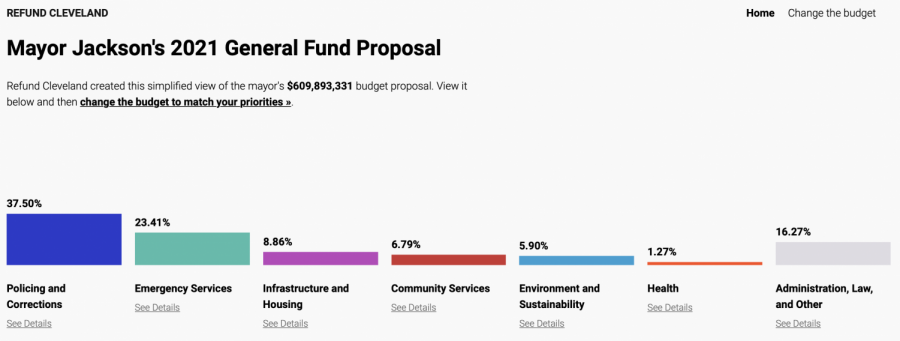Editorial: Cleveland gets a new budget
Courtesy of refundcleveland.com
Refund Cleveland uses graphics to break down the 2021 operating budget, illustrating the largest apportions to policing and the smallest to health.
February 26, 2021
At the beginning of February, Cleveland Mayor Frank G. Jackson released his proposed $1.8 billion general fund budget for 2021. City utilities and Hopkins International Airport make up two-thirds of the budget, leaving approximately $660 million to fund other general services. This budget is largely comparable to that of previous years, though slightly reduced to accommodate for the loss of revenue from the pandemic. As Case Western Reserve University students and, generally, constituents of Cleveland, The Observer believes it’s important to be engaged with the community and understand the implications of our local government. As such, we will briefly review the budget and overall changes in Cleveland for the upcoming year.
Encouragingly, Cleveland has established a new Division of Health Equity and Social Justice within the Department of Public Health. However, let’s not forget this is a direct result of the investigation into racial discrimination in the department. Let’s hope the new division is able to aggressively confront the discrimination within the city department and better address how systemic racism has caused health inequities and disparities.
As far as the budget goes, each year, Mayor Jackson’s office—in conjunction the Committee of Finance—releases a 500-page document with information about Cleveland, social and financial updates, General Fund breakdowns by department, and data on Special Revenue funds, Major Enterprise and Small Enterprise funds, Debt Service funds, Internal Service funds and Agency funds. The General Fund is broadly responsible for all the services that apply to us each day: police, fire and emergency departments, waste collection, recreation and housing codes. The Special Revenue Fund is responsible for restricted income taxes, street construction, the city’s rainy day account (money set aside for emergency situations) and school activities. The Major Enterprise fund is for operations like public utilities and the airport, while cemeteries, municipal parking lots, golf courses and West Side Market fall under the Small Enterprise fund. Debt Service payments are, well, exactly as named. Internal Service funds assist other city departments and the Agency fund holds all city assets.
Now that the intricacies of the budget have been established, we can move onto what the budget looks like for 2021 and how much money is proportionately distributed across different public services. The 500-page budget released by the Mayor’s office is a bit overwhelming—in both length and content, especially if you, like us, are unfamiliar with financial charts. Fortunately, there are a few key organizations that help make the budget more digestible for us lay persons.
Open Cleveland is a group of developers and coders who helped create a website called Refund Cleveland. This website not only visually outlines the city fund every year, but also provides an easy submission portal for all Cleveland residents to share their input on how the budget should be apportioned. They exist to make the budget understandable—after all, it’s mostly taxpayer money that makes up the budget, so we should have a say in city policy and financial priorities. Similarly, Cleveland Documenters, created by the Neighbor Up organization, pays Cleveland residents to document government meetings. Like Open Cleveland, they work to make governmental meetings and resources more accessible and understandable to residents.
Once the mayor’s office releases the budget, the City Council holds hearings to discuss the spending priorities. After a few reviews and any necessary amendments, the budget must be approved by April 1 and publicly disseminated.
In addition to the breakdown of the budget provided above, we can also consider a more simple division: Operating Budget and Capital Budget. The former is responsible for paying and providing benefits to city employees, and the latter is apportioned for infrastructure investments. The Operating Budget is typically more emphasized, as it’s responsible for the daily functioning of the city, while the Capital Budget considers future expenses.
As such, Refund Cleveland’s tool only considers the Operating Budget. Their visual representation of the budget illustrates that 37% is allocated for policing and corrections, 23% for emergency services and 16% for administration. The remaining 24% is split between infrastructure and housing, community services, environment and sustainability, and health. Health disproportionately makes up the smallest fraction of the budget at only 1.27% of the $600 million.
Considering the impact of the pandemic and, in general, Cleveland’s poor health outcomes—especially for low-income communities and communities of color—it’s incredibly disappointing that the health budget is so dreadfully low. Major Jackson’s letter at the beginning of the budget estimate stated, “The pandemic highlighted that for years, people have faced inequities when finding jobs, accumulating wealth, accessing health care and obtaining a positive outcome.” And yet, police funds make up nearly half the budget while infrastructure and health care, together, make up less than 10%.
Moreover, it is incredibly frustrating that there is no governmental avenue to share input on the budget. As such, we need to appreciate and support Refund Cleveland’s “Change the budget” feature, which will collect your proposed budget breakdown and share it with the councilperson that represents your ward. It offers an expedited alternative to contacting a councilperson—University Circle is in Ward 9 with Council Member Kevin Conwell—and sharing your thoughts over email or phone.
After a stressful first week of exams and papers, we encourage you to take some time to further review either the budget, the resources by Documenting Cleveland that highlight how the budget process works or Refund Cleveland, which offers you the opportunity to share your thoughts on the funding allocations.
One thing we can say for certain is that addressing public health, health disparities and lead poisoning—among the other issues facing Cleveland—will certainly not be solved by the new Division of Health Equity and Social Justice if they’re only working with less than 1% of the budget. It’s nearly impossible to push for drastic social changes if the budget is supporting a different agenda.


